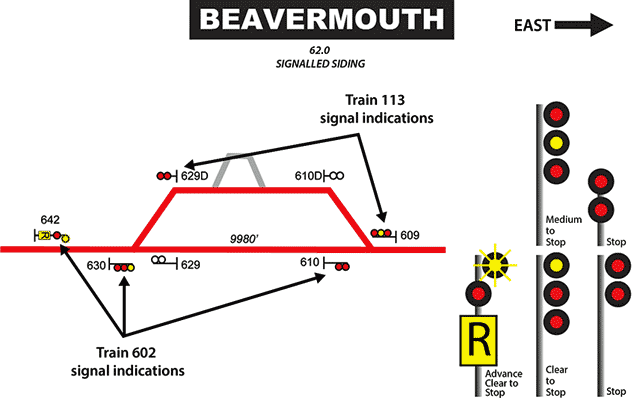
Signals Are Followed
Gatineau Quebec - The Transportation Safety Board of Canada (TSB) today released its
Investigation Report R15V0183 on the collision between two
Canadian Pacific Railway (CP) trains at the Beavermouth siding near Golden, British Columbia.
The investigation highlights deficiencies with following railway signal indications, a TSB Watchlist issue.
On 6 Sep 2015 an eastbound CP train collided with a westbound CP train that was entering the Beavermouth siding.
Because the westbound train exceeded the length of the siding, some of its cars were still on the main track.
As a result of the collision, two locomotives and the first car derailed on the eastbound train, as did one set of trucks on the 64th car of the westbound
train.
The conductor of the eastbound train sustained a serious injury.
No dangerous goods were released.
The collision occurred when the eastbound train was operated past the Stop signal at the east siding switch at Beavermouth, and continued into the side of one
of the cars from the westbound train that was still on the main track.
Maintenance activities for a major track restoration project were underway in the vicinity of the occurrence location, and both trains traversed a number of
work zones and slow orders before the collision.
As the eastbound train was approaching the east siding switch, the crew realized that they had not complied with two previous slow orders during the
trip.
The investigation determined that the crew on the eastbound train was not aware that the length of the westbound train exceeded the length of the
siding.
As such, the crew's expectation was that the westbound train would be clear of the east siding switch and that they would receive a permissive signal
indication.
Additionally, heavy radio use between work crews and rail traffic control precluded the sharing of information about the westbound train's length.
Preoccupied with missing two previous slow orders during the trip, the crew was likely distracted as they approached the east siding switch.
There is a risk that slow orders can be missed if they are not identified with trackside flags.
The lack of adequate defenses for ensuring railway signals are consistently followed were highlighted in this investigation.
If signal systems do not include physical fail-safe capabilities, the risk of collisions and derailments from not following signal indications will
persist.
The Board has previously issued two recommendations for additional physical defenses (R00-04 and R13-01) to protect against missed railway
signals.
The Board has also indicated that on-board voice and video recorders could be used proactively and in a non-punitive way to enhance a railway's safety
management system, helping to reduce risks.
Following the occurrence, Transport Canada issued a Notice and Order to ensure that trackside slow order flags are installed in a timely manner.
For its part, CP enhanced its processes to ensure that slow order flags are installed as required by regulations.
Author unknown.
of the Canadian Copyright Modernization Act.


